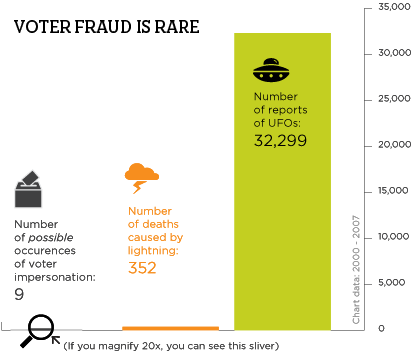
A new post by Rick Hasen, a renowned election law expert, Why Large Scale Voter Impersonation Plans Can’t Work, on Election Law Blog takes on an aspect of elections that is not often discussed. Impersonation fraud is extremely rare but involves basically voting under someone else’s name and stealing their vote. As Hasen explains, its not very scalable:
No wonder almost all serious efforts at fraud involve either election officials committing fraud or absentee ballot fraud, which takes place outside the supervision of poll workers and election workers. It’s why we can’t find a single election at least since 1980 where impersonation fraud plausibly could have used to change the outcome of an election. Yet we have ample examples of absentee ballot fraud and election officials committing fraud.
 According to an article in the Telegraph by Alli Knothe entitled, “2 charged with voter fraud in Worcester”, the two Massachusetts men were locals:
According to an article in the Telegraph by Alli Knothe entitled, “2 charged with voter fraud in Worcester”, the two Massachusetts men were locals:
Mark Atlas, 50, was accused of voting at the Ward 6, Precinct 5 polling station at 337 Greenwood St. under someone else’s name. Richard Suchocki, 57, has been accused of assisting Mr. Atlas by providing him with the name and address of another registered voter. He was arraigned Monday.
The impersonation team (as it were) got caught after some observant poll workers noticed their attempt to vote twice:
When that registered voter went to the precinct to cast his ballot, he appeared to have already signed in, said Sgt. Kerry Hazelhurst. An officer working there overheard the conversation and looked into what happened. A poll worker remembered the name of one of the men and police investigated.
Voter impersonation is incredibly rare, as described by New York University’s Brennan Center for Justice who have worked extensively in this area:
 It’s important to protect the integrity of our elections. But we must be careful not to undermine free and fair access to the ballot in the name of preventing voter fraud. The Brennan Center’s ongoing examination of voter fraud claims reveal that voter fraud is very rare, voter impersonation is nearly non-existent and much of the problems associated with alleged fraud in elections relates to unintentional mistakes by voters or election administrators. Our report “The Truth About Voter Fraud” reveals most allegations of fraud turn out to be baseless — and that of the few allegations remaining, most reveal election irregularities and other forms of election misconduct.
It’s important to protect the integrity of our elections. But we must be careful not to undermine free and fair access to the ballot in the name of preventing voter fraud. The Brennan Center’s ongoing examination of voter fraud claims reveal that voter fraud is very rare, voter impersonation is nearly non-existent and much of the problems associated with alleged fraud in elections relates to unintentional mistakes by voters or election administrators. Our report “The Truth About Voter Fraud” reveals most allegations of fraud turn out to be baseless — and that of the few allegations remaining, most reveal election irregularities and other forms of election misconduct.
Voter fraud is not acceptable in our elections, but we must find a balance and not impose solutions that make it harder for millions of eligible Americans to participate in our democracy.
An article from the Washington Post, describes a landmark study on the issue:
The analysis of 2,068 reported fraud cases by News21, a Carnegie-Knight investigative reporting project, found 10 cases of alleged in-person voter impersonation since 2000. With 146 million registered voters in the United States, those represent about one for every 15 million prospective voters. The News21 report is based on a national public-records search in which reporters sent thousands of requests to elections officers in all 50 states, asking for every case of alleged fraudulent activity — including registration fraud; absentee-ballot fraud; vote buying; false election counts; campaign fraud; the casting of ballots by ineligible voters, such as felons and non-citizens; double voting; and voter impersonation.
The analysis found that there is more alleged fraud in absentee ballots and voter registration than in any of the other categories. The analysis shows 491 cases of alleged absentee ballot fraud and 400 cases involving registration fraud. Requiring voters to show identification at the polls — the crux of most of the new legislation — would not have prevented those cases. The analysis also found that more than 46 percent of the reported election fraud allegations resulted in acquittals, dropped charges or decisions not to bring charges.
See the hyperlinked timeline of the Brennan Center’s work on voter fraud, including work on restrictive photo ID requirements.
- Analysis & Reports: Policy briefs, reports, and other national resources assessing allegations of voter fraud.
- Case Studies by Issue: Examinations of voter fraud claims, sorted by the type of fraud alleged.
- Case Studies by State: Examinations of voter fraud claims, sorted by the location of the fraud alleged.
- Commentary: Opinions and editorials on the hunt for individual voter fraud.
- Litigation: Materials assessing claims of voter fraud, filed in court cases around the country.
- News: Links to news stories, press releases, and announcements about voter fraud.
Encopretic says
Well, this article is complete bullshit. First off, there were more than 10 in-person acts of voting fraud in the last election alone, so that immediately makes the claim bullshit.
Second, it’s impossible to claim that there wasn’t fraud if nobody was checking ID in the first place.
Can we please stop acting like these people who allegedly can’t get their shit together to get an ID are actually going to get the energy to get off their butt on election day? Not requiring people to prove who they say they are is a ridiculous mockery of the importance of voting.